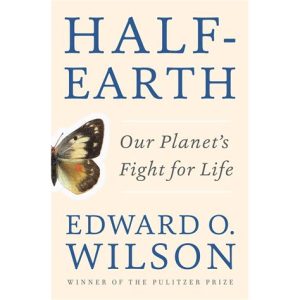Half Earth – Edward Wilson
The One Sentence Summary – In order to stave off the mass extinction of species, including our own, we need to dedicate half the surface of the Earth to nature.
WHAT THE BOOK SAYS
- The author is a world-renowned biologist who died in 2020 (check).
- Man has many traits, including lucky accident of primate evolution, a yearning to be more master than steward of a declining planet, arrogant, reckless, lethally disposed to favour self, tribe, and short-term futures, obsequious to higher beings and contemptuous to lower forms of life.
- The half-earth proposal is to dedicate one half of the earth to protected biodiversity areas in order to solve the current Sixth Extinction. It is one half because large plots harbour many more ecosystems and species composing them at a sustainable level. Expressed in simple maths, if 90% of a biodiverse area is removed, the sustainable number of species in it will drop to 50%. If 10% of what is remaining is removed, (a team of lumberjacks could do this in a month or so), then most or all of the surviving residents will disappear.
- The situation facing us is too large to be solved piecemeal and so the solution needs to be commensurate with the magnitude of the problem. Specific regions can still be reclaimed to achieve the goal.
- The author wrote to 18 of the world’s senior naturalists and asked them to nominate areas with unique and valuable species of plants, animals, and microorganisms.
- The recommendations can be viewed as a semi-contiguous belt covering the redwood forests of California, the Madrean pine-oak woodlands of Mexico, Cuba and Hispaniola, the Amazon basin, the Guiana shield, the tepuis of Venezuela, the greater Manu region of Peru, cloud forests of Central America, the Paramos grasslands and Atlantic forest of South America, the Cerrado and Pantanal of Brazil, the Galapagos, the forests of Poland and Belarus, Lake Baikal in Russia, the Christian Orthodoxy Church forests in Ethiopia, Socotra off Yemen, the Serengeti, Gorongosa National Park in Mozambique, most of South Africa, forests of the Congo, the Atewa Forest in Ghana, Madagascar, the Altai Mountains in Central Asia, the Western Ghats of India, Bhutan, Myanmar, the scrubland of Southwestern Australia, the Kimberley region of Northwestern Australia, New Guinea, New Caledonia, the McMurdo dry valleys in Antarctica, and Hawaii.
- Humans are still organisms dependent on other organisms. We obey the Rule of Threes: you can live for three minutes without air, three hours without shelter or proper clothing in freezing cold, three days without water, and three weeks without food. Our history makes no sense without prehistory, which makes no sense without biology. We all came from somewhere.
- 18 countries, home to half the world’s population, have a water crisis and are draining their aquifers. We consume a quarter of Earth’s natural photosynthetic productivity.
- The Anthropocene Epoch is the biologically final age in which the planet exists almost exclusively for, and of, ourselves. The author prefers to call it the Eremocene – the Age of Loneliness.
- The Anthropocene ideology is a movement that claims in essence that traditional efforts to save the earth’s biodiversity have failed. Pristine nature no longer exists, and true wilderness is just a figment of the imagination. So you might as well treat it as a commodity and let it run its course to destruction. Such observers often lower the bar of baseline data to make it seem as though human effects are not such a great deal, but they should really be going back to proper pre-human data to give an accurate picture.
- Through a massive failure of education and media attention, we have created a black night of ignorance about millions of species that support the living world.
- The current rate of extinction is between one hundred and one thousand times higher than it was originally, all due to human activity. This threatens to extinguish or bring to the brink half of the species currently still surviving.
- The HIPPO acronym summarises our most ruinous activities:
-
- Habitat destruction
- Invasive species
- Pollution
- Population growth
- Overhunting
- There are currently 2 million species known to man, with a suspected 6 million more probably undiscovered.
WHAT’S GOOD ABOUT IT
- Examples of extraordinary diversity in the natural world include:
- Vampire hunters. Jumping spiders seek out female mosquitoes that have recently fed on blood.
- Zombie masters. Viruses of gypsy moth larvae reverse their behaviour by making them climb trees in daylight and release clouds of more virus.
- Orchids are masters of deception, often using their patterns to imitate insects, who then spread their pollen to other orchids.
- Slave makers. Ants are known to steal the pupae of other ant colonies and bring them up as slave workers.
- Giant killers. Working in teams and with mandibles ready, groups of ants can eat prey 13,350 times their individual weight.
- In the fullness of time the mapping of Earth’s biodiversity will become a Big Science project, helped by modern technology. There are about 1,000 people alive for every species, so in theory a sponsor could be found for every one of them.
- “All of man’s troubles are due to the fact that we do not know what we are and cannot agree on what to become.” Jean Bruller
- “The most dangerous worldview is the worldview of those who have not viewed the world.” Alexander von Humboldt
WHAT YOU HAVE TO WATCH
- The author is such an expert that the lay reader may struggle with the scientific detail on some points, but the overall thesis is crystal clear.





Leave A Comment
You must be logged in to post a comment.